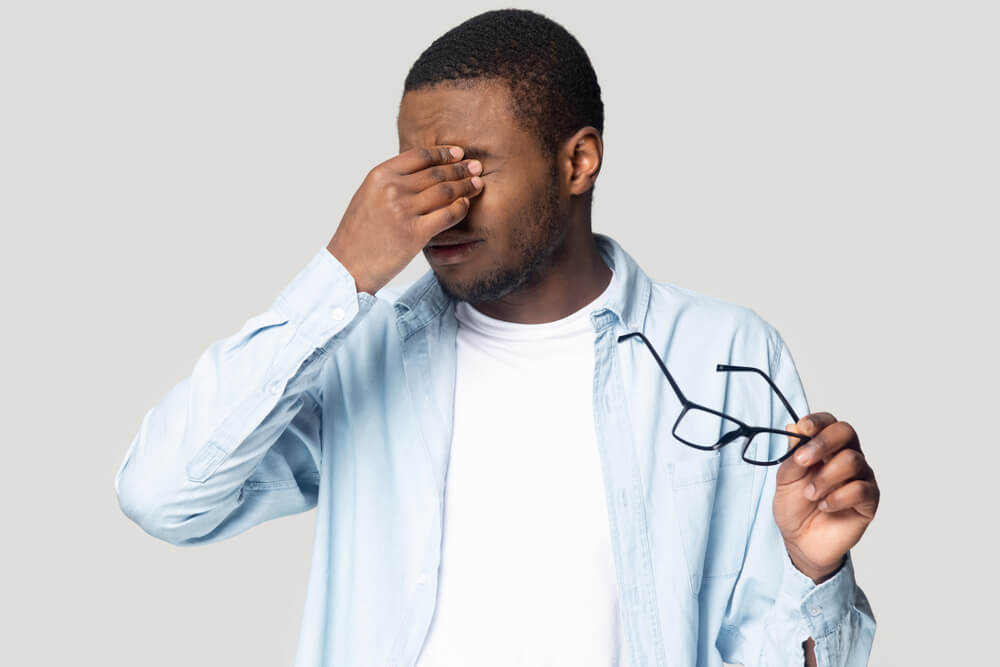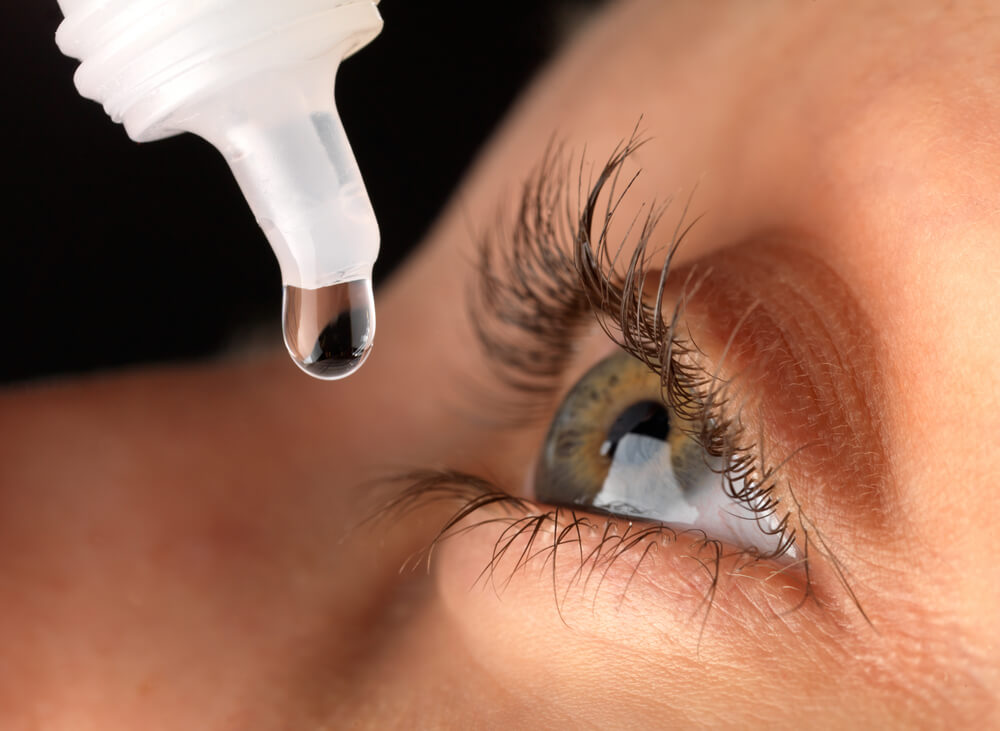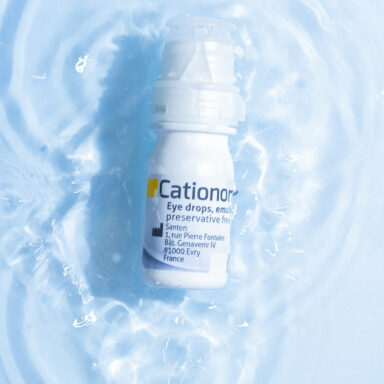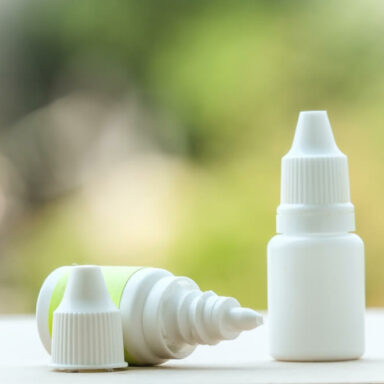If blurry blinkers are giving you tears of frustration you’ve come to the right place. Here, we unpack the causes, what you can do about them, when to see a doctor and treatment options.
Causes of watery eyes
You’re not alone in your watery woes – 1 in 5 babies, nearly 1 in 10 children (8%), and most adults develop watery eyes at some point in their life, especially those aged over 50 years.1,2
Did you know?
As many as 1 in 3 women (32%) develop watery eyes after the menopause.1
Although it’s common, it’s more than a minor annoyance. Persistent watery eyes can have serious consequences if you’re a contact lens wearer and unable to wear them, operate heavy machinery or find yourself constantly rubbing your eyes and increasing your chances of an infection.3

From chopping onions to the common cold, changes in weather, medication side-effects and even hormones, there are a great number of things which can cause our eyes to water!4,5,6,7 Here’s some of the most common and important ones to know about:
Allergies
Pollen, pollution, dust and pet dander can trigger the body’s immune system to release histamine, a chemical which stimulates our natural defences, such as sneezing, itching and, you guessed it, teary eyes.8
Dry eyes
It’s ironic, but dry eyes can actually cause watery eyes. When your eyes are dry, the body can overcompensate, causing too many tears to be produced.5 It’s one of life’s annoying paradoxes like needing the toilet and a glass of water at the same time.

Blepharitis
Blepharitis is caused by bacteria or a problem with clogged oil glands. Aside from redness, irritation and inflammation, a tell-tale sign of Blepharitis is crusty flakes along the eyelashes.9
Eye infections and injury
Infections of the eye, such as conjunctivitis (also known as pink eye), or eye injuries, such as from a foreign object, cause the eye to become inflamed.10,11 As a defence mechanism, the body produces tears to help flush out any irritants or infection, and to keep the eye lubricated and comfortable.
Did you know?
Babies often have watering eyes because their tear ducts are small. It usually gets better by the time they’re 1 year old.11
Lifestyle changes to help reduce watery eyes
Lifestyle changes might not stop all your tears, but in many cases, they can help and make life a little more comfortable from itching watery eyes.
Reduce screen time
When we look at digital screens for extended periods of time, we tend to blink less frequently, decreasing the number of tears that are spread across the eyes, which can result in dryness and watery eyes.12 The blue light emitted by digital screens can also contribute to dryness and eye fatigue.13
Practice good hygiene
Make sure you always wash your hands with soap and water before touching your eyes, remove your eye makeup before going to bed each night, clean and replace contact lenses as instructed, use clean towels and washcloths, and avoid sharing eye make-up.
Avoid allergens
In real life, it’s not always possible to avoid exposure to allergens, but if you know something irritates your eyes, try to limit your exposure. For example, with pollen, try to stay indoors while counts are high, keep your windows closed, use air conditioning with a HEPA filter, and regularly clean the home.
Stay hydrated
Drinking plenty of water can help prevent dehydration and dry eyes – a cause of watery eyes.14 Carry a reusable water bottle with you throughout the day to make it easy to drink regularly.

How to soothe watery eyes at home
While it’s important to get watery eyes checked by a healthcare professional so you can get the right treatment, there are some things you can do at home to feel more comfortable in the meantime:
Use a warm compress
Soak a clean washcloth or towel in warm water, then wring it so it’s damp. Gently hold it over your closed eyes for about 5 to 10 minutes, or until it cools down. You can repeat this several times a day as needed.15
Top tip
Try adding Chamomile herbal tea bags to help soothe inflammation and irritation.15
Adjust your environment
If you’re spending time in an air-conditioned environment, consider using a humidifier to add moisture to the air. This can be helpful if dry eyes are the underlying cause.
Avoid wearing contact lenses
If you wear contact lenses, consider switching to glasses for a while to allow your eyes to rest and recover. Some types of lenses can absorb some of the tears and create a barrier that prevents oxygen from reaching the cornea, which can lead to irritation and inflammation.16
Dry eye and watery eyes
As we mentioned earlier, dry eyes can actually cause watery eyes. It happens when your eyes don’t produce enough tears or when the quality of your tears is poor – there are many reasons for this including natural aging, pregnancy, eye surgery and autoimmune conditions like Sjogren’s syndrome. 17,18,19 In addition to watery eyes, your eyes may feel20,21:
- Dry, gritty, or sandy, as if there is something in your eye
- Bloodshot, or irritated
- Burning or stinging
- Sensitive to light
- Tired, heavy, achy

When to see a doctor for watery eyes
While watery eyes are not usually a serious condition, there are times when you should seek medical attention:
- If you experience sudden, severe eye pain or vision changes
- If your watery eyes are accompanied by discharge or a crusty build-up around your eyelids
- If your symptoms persist despite home remedies and lifestyle changes
- If you have a history of eye problems or are at risk for eye diseases such as glaucoma or cataracts
Did you know?
Our bodies normally produce 2 microlitres of tears per minute – that’s 10oz or 283g per day!22
Treatment options for watery eyes
The treatment for watery eyes depends on the underlying cause of your symptoms. Some of the most common treatments include over-the-counter or prescription eye drops, antibiotics (if an infection is the cause), surgery (in rare cases), allergy medications or topical steroids.11
Can eye drops help my watery eyes?
Often, the answer is yes – either on their own or in combination with other treatments.8 Here are some of the ways they can help:11,23,24
- Lubrication – moisturise your eyes and reduce dryness, which may in turn reduce excessive tearing.
- Anti-inflammatory – some eye drops contain anti-inflammatory active ingredients such as steroids (prescription) or aloe vera (over-the-counter).
- Allergy relief – antihistamine eye drops can help block the release of histamine, which triggers allergy symptoms like those of hay fever.

Eye drops, such as Cationorm®, can quickly relieve discomfort if your watery eyes are caused by dry eye. It acts like the body’s natural tears to provide long-lasting relief, is preservative free and kind to even sensitive eyes. Always read the label.
Did you know?
Not all eye drops are created equal! Some eye drops containing preservatives, can worsen symptoms for certain people.25
Fortunately, watery eyes are usually temporary and highly treatable, but it is important to work out the underlying cause.11 For more information, speak to your pharmacist, doctor or eyecare specialist.




